Category Archives for Student Feedback
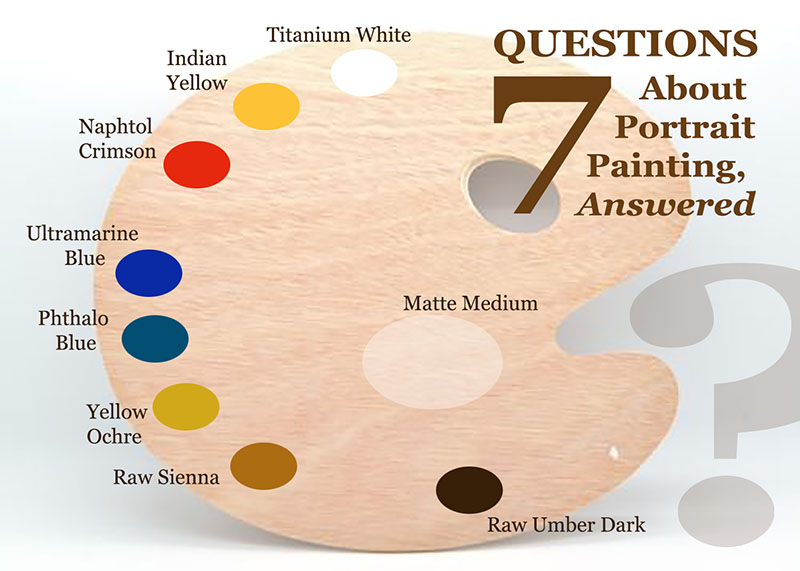
7 Questions About Acrylic Portrait Painting, Answered
Are you just starting out in acrylic portrait painting? If so, chances are you have wondered about at least a few of the questions I’ll be answering in this article. Who knows, maybe all of them!
Today, I’m going to answer seven fantastic questions from a follower of mine named Andrea. The questions deal with everything from what colors and brushes to use, to blending, to some advanced techniques.
Read below to find out if one of your questions gets answered…
Q #1: What should be my basic color palette for portraits, and mixes for shading?
A: This is my basic palette for painting portraits. I would also have titanium white on it in the upper corner, by the indian yellow. Typically, I start out with raw umber dark and ultramarine blue thinned down with clear matte medium to block in the darker values. I make them into a very translucent glaze of 90% or more medium to 10% or less pigment. Eventually, I work my way into the warmer tones with burnt sienna, raw sienna, and alizarine crimson. The raw umber dark is used to counter-balance those glazes so they don’t get too warm/ orangish.

Q #2: What sort of brushes should I be using?
A: I don’t use anything fancy. Just brushes you can buy at your local art store in a multi-pack, ranging from 1″ flat/ 1/2″ flat, 3/8, flat, and a varied assortment of rounds from size 4 to 3/0. I go through a lot of brushes, so I don’t get anything expensive. But I do have a few nice ones for surface shading and the final varnish coat.
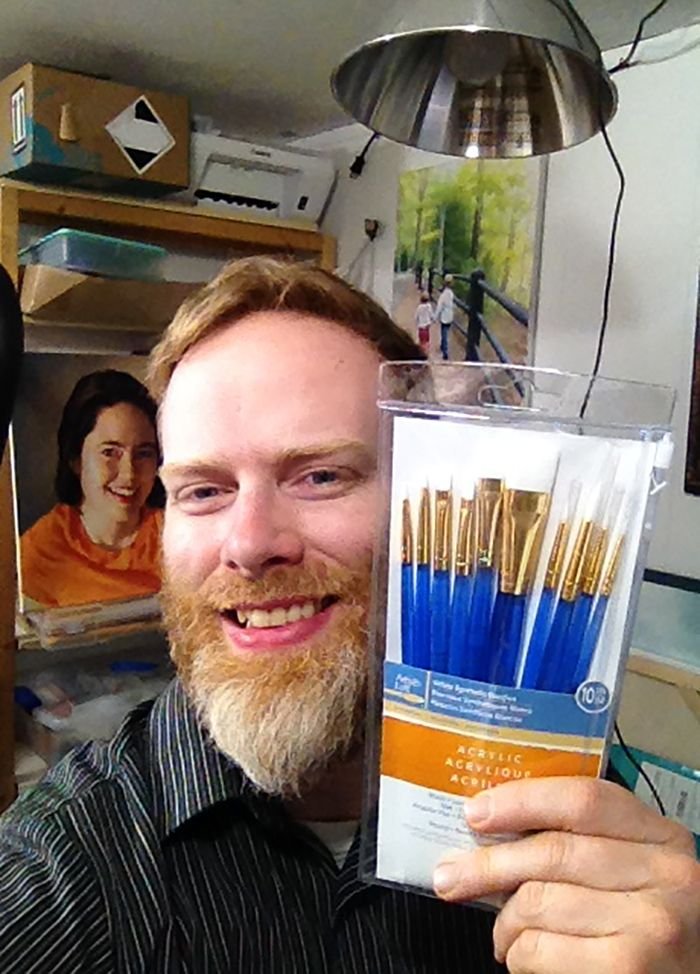
Q #3: How do I keep my paints from drying up, or drying immediately they are applied before I have chance to blend them? I do have retarder but should I be adding this to every color on my palette before I start?
A: No, I don’t recommend a retarder. Some artists like it, but for the classical glazing technique that I use, the faster the paint dries, the better (within reason). Basically, I love the quick drying glazes. It means I can be ready for another coat in about 10-15 minutes. I work various parts of the painting, cycling from the background to the foreground, from the hair to the face, from the clothing, the eyes–whatever. That way, when I move to another part of the portrait, it’s already dry and ready to work on.
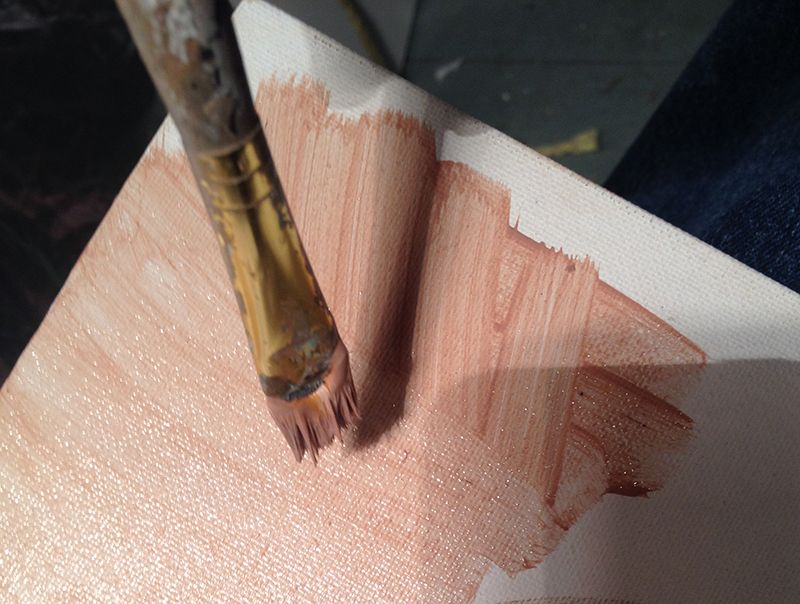
Q #4: How do I shade?
A: I have five different ways to blend. Check out my latest blog post here for more info on these techniques…
How I Painted the Portrait of My Pastor and His Wife
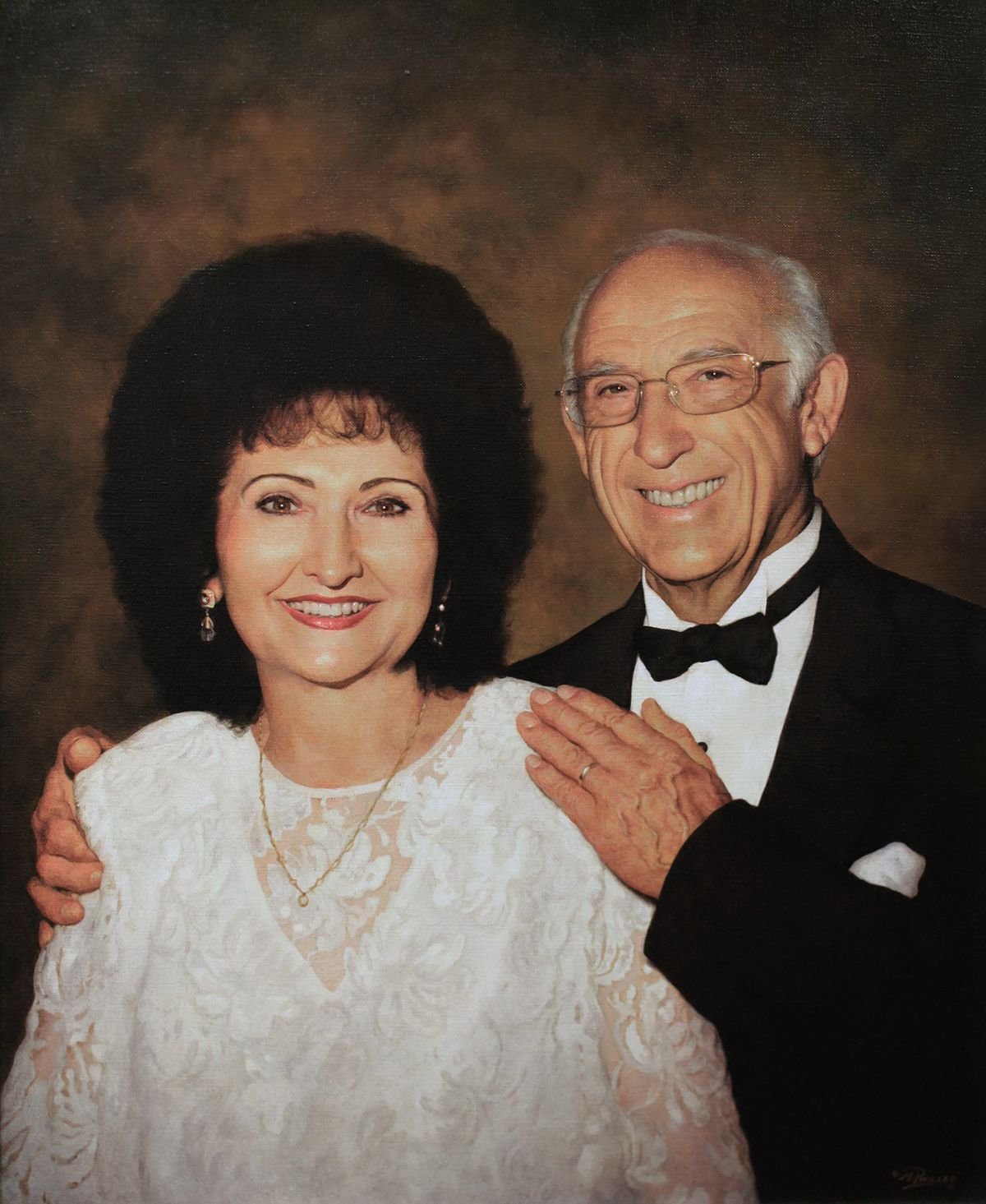
How I Painted the Portrait of My Pastor and His Wife
If you’d like to delve further into how to shade, I created a course on it: “Shade With Acrylic Like a Master.”
Q #5: In what order should I paint? I started with the background.
A: I sometimes start with the background, but not always. I want to establish contrast as soon as possible. So I try to fill in the darkest values first. It may be the background, but not necessarily. You can see the progression of how I work below on this example painting, “Smoldering Wick” (30″ x 40″ acrylic on canvas).

Notice, I filled in the darkest values first, and then moved to the lighter areas last…

Q #6: How do I tackle difficult aspects, such as deep creases from the nose to the mouth, the sides of the mouth and wrinkles?
A: I need to do a course on this. Others have chimed in as well, saying they really would like to see how it’s done. I’ll probably start out with a couple videos on the topic and then move into a longer course. But to answer your question, I’ll say this: look for the shadow first. Notice where the light source is at, and then the crease will be shaded on the opposite side. On the side facing the light, there will be a highlight.

Here’s how you do it:
- You paint the shadow of the crease in first, with a thin that’s fairly faint, and that’s one layer.
- Next, you go over that with another layer, that darkens just a few spots within that crease. In any crease or wrinkle, there will always be some areas that are deeper than others, and those need to be darker.
- You paint a thicker line on top of the first line. This line should be even more faint than the existing line, and the color should be slightly warmer.
- You paint a highlight on the opposite side. It should be about the same color as the flesh tone surrounding the crease, but a couple shades lighter and warmer too.
- You may need to add a couple more layers to both the shadow and the highlight to blend it in appropriately.
One quick tip: start out faint and go progressively darker. This is the number one mistake I see in portraits. Artists notice creases and wrinkles, but they paint way too prominently.
Would you like to learn more about how to paint wrinkles? If so, let me know by clicking the button below, and I’ll create a video tutorial/ course for you!
Q #7: What colors should I use for each area, especially the top eyelid, the mouth and the shadows under the eye?
A: This depends on the person. You need to really pay attention to the colors in the picture you’re working from. Generally under the eye, the colors are a bit cooler, because the skin is thinner there and you see the blood vessels on the surface. So, use some ultramarine blue, alizarine crimson, and raw umber dark mixed together and thinned out into a very light glaze. Then go over the area under the eyes with that.
For the mouth, you’ll need alizarine crimson, and napthol red, but it depends on the person. Obviously, a woman with lipstick will need more red on her lips. But even some men have lips that are more red than others.
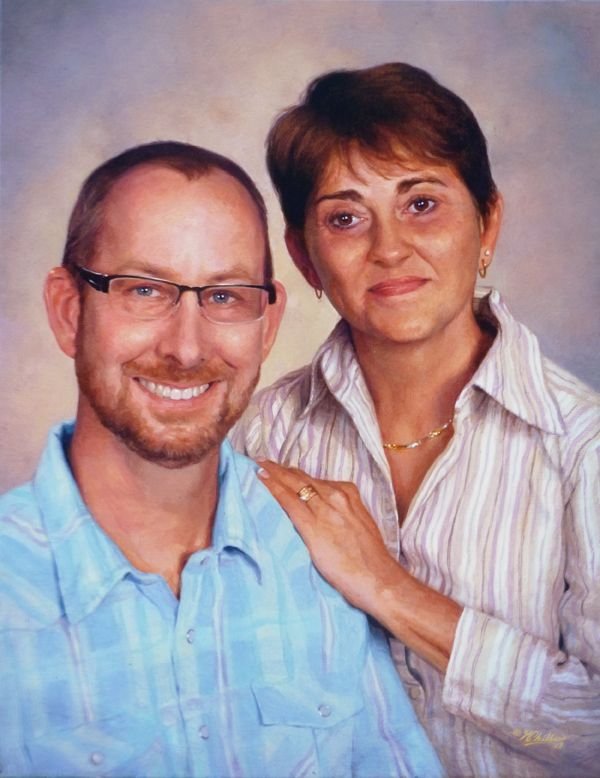
Let me know how this post helps in your portrait painting. (If you’re not an artist, but you found this interesting, I’d love to hear about it. )
May God bless your painting,

P.S. Is there a question YOU have that wasn’t covered in this post? Just ask! I’d love to help.
If you found this post helpful or encouraging, would you send it on ahead? Let others know with the share buttons below. I’d love to hear your comments. Thank you so much!
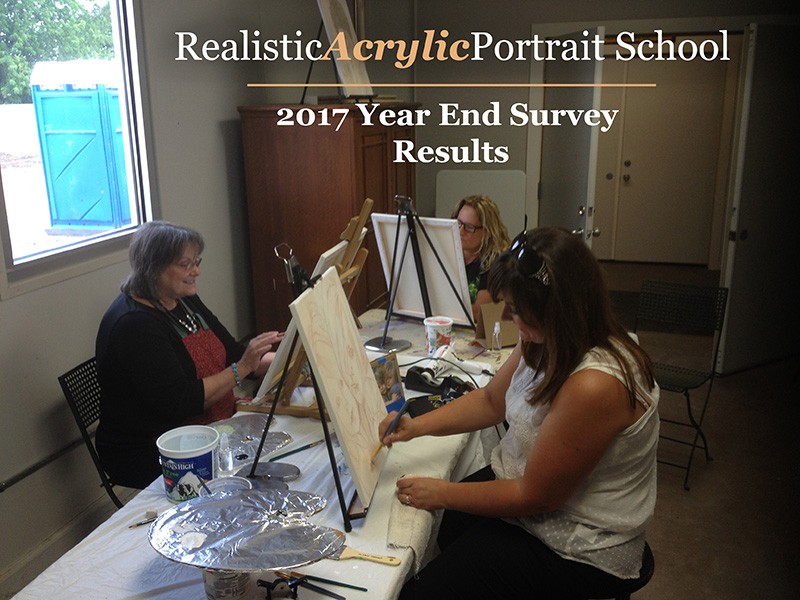
2017 Year-End Survey Results
“What do you want me to teach on in 2018?”
At the end of last year, (which was not long ago as I write this) I sent out a survey to my students and email subscribers asking this question–in many different ways.
Specifically, I asked 12 questions to nearly 800 subscribers.
From those who participated, the responses to the survey surprised me a bit. They may surprise you as well!
Question #1
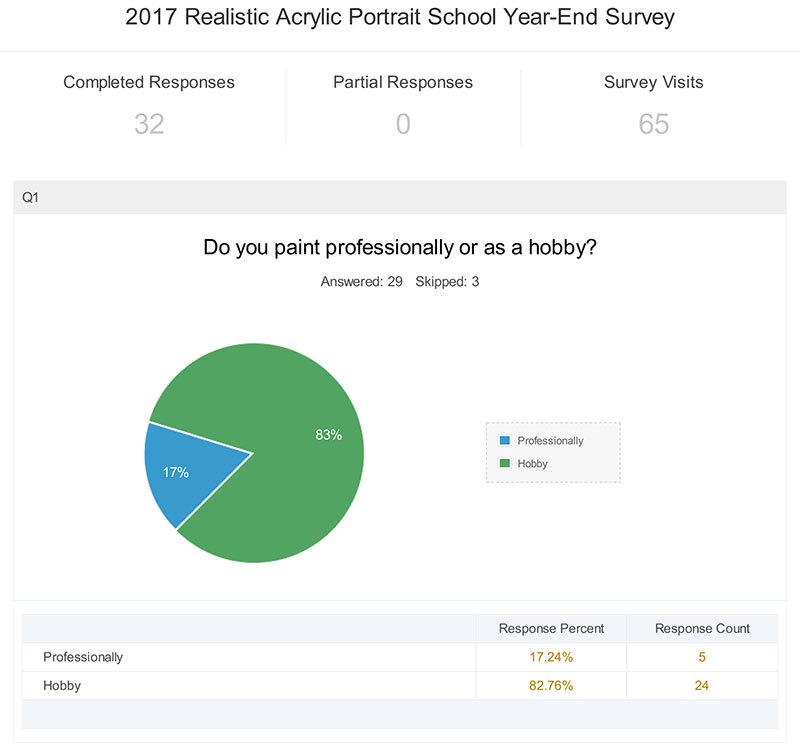
Interesting. I knew most of my subscribers were hobbyists but I didn’t know the percentage was that high.
Question #2
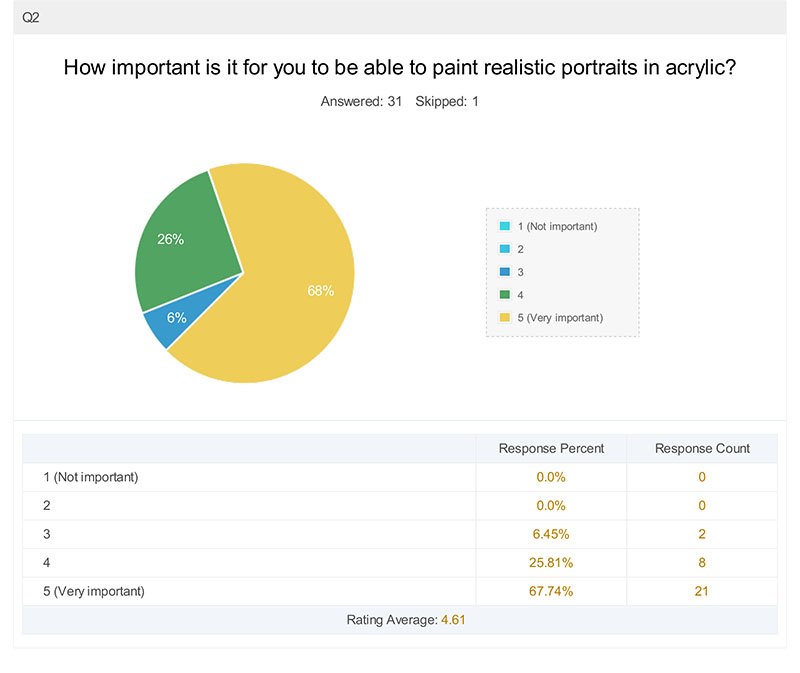
This is good for me to know. Because if you want to learn how to paint abstract portraits, for example, you’re probably in the wrong place!
Question #3
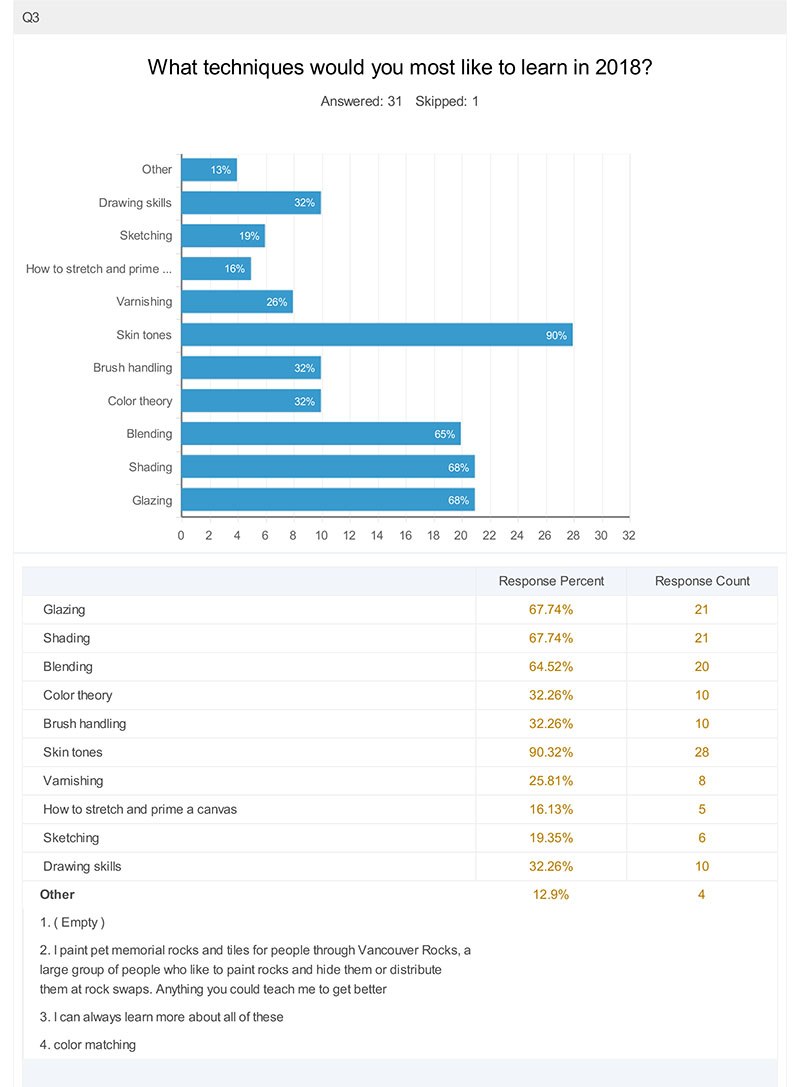
I knew skin tones would be the highest scoring, based on the conversations I’ve had on Facebook and in direct emails. Shading comes in at second place. So I guess it’s good that I already did a course on shading.
But apparently I should do one on skin tones! 🙂 And there’s plenty of other topics I can teach on too.
Question #4
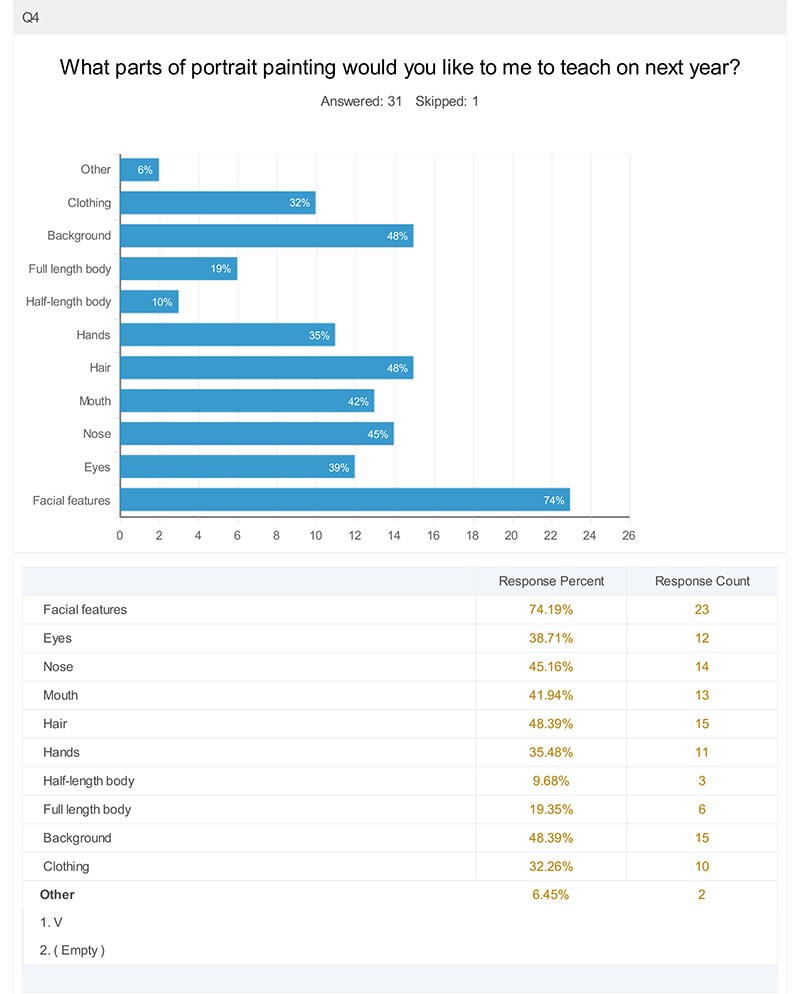
Now, I probably should have phrased my question better. Facial features really are eyes, nose and mouth all put together. But I think my subscribers were trying to say they’d like to learn how to do accurate portraits. How to capture the likeness correctly…yes?
I find it interesting that learning how to paint hair score higher than eyes. And the nose came in right after that.
Well, noses are tricky.
Maybe a course on painting noses would sound a little odd, but I’ll do it if that helps my students paint better portraits!
Question #5
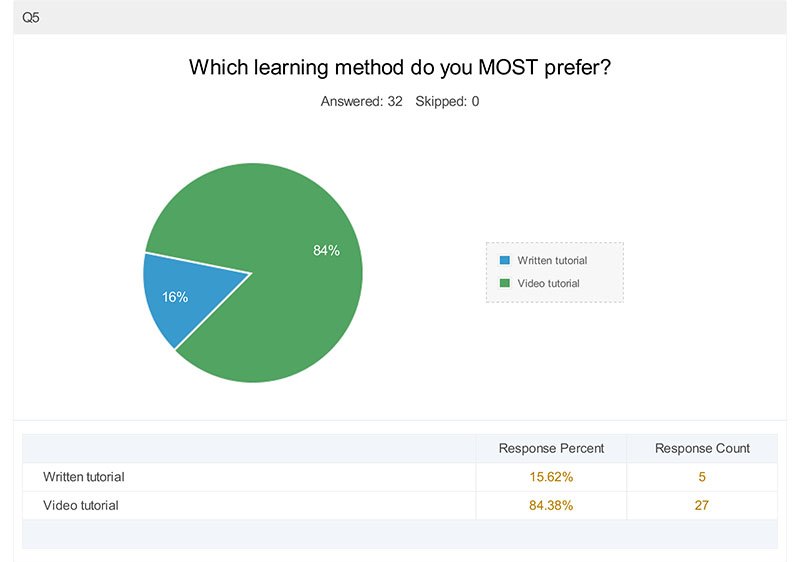
This totally amazed me. I know people like videos, but that is conclusive. I need to do more videos. I’ll still do some written tutorials here, but I am going to imbed some videos into the articles as much as possible.
Question #6
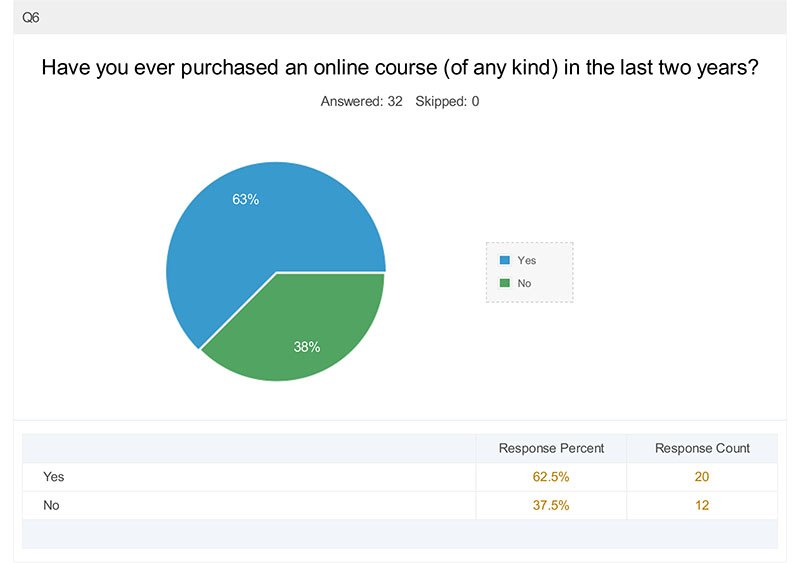
It’s pretty amazing that a majority of my readers have purchased an online course. Amazing what technology can do and how it can bring us together from all parts of the globe!
Question #7
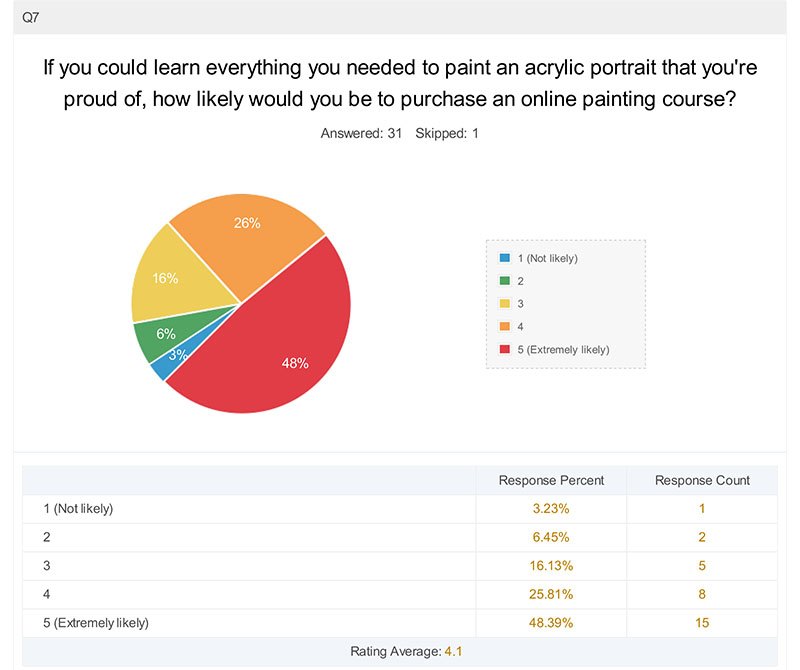
This is a good stat right here. Nearly half of my subscribers would buy a course if they KNEW they would learn everything they needed to be able to paint that amazing portrait. And another fourth would be pretty likely to, again if they were confident they’d get the outcome they’re seeking.
My goal then, will be to show you that I can teach you exactly what you need to do just that, and to make the transaction risk-free as possible for you.
Question #8
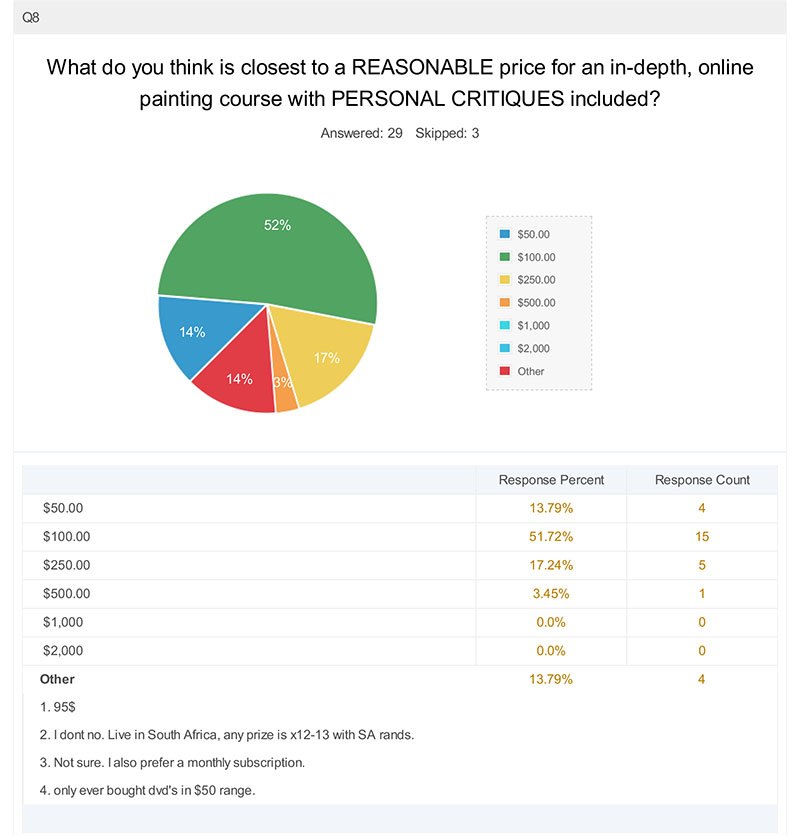
Okay, so it looks like I’m right on the money with what I charge for my course. Good to know. Obviously, I need to make a living as an artist and teacher and don’t want to under-price my labors, but I don’t want the price so high, that you can’t afford it. I can’t tell you how many times I’ve wanted to purchase a course on blogging or marketing, and then the price is $2,000 or more.
Really?
I could buy a nice used mini-van for that to haul more of my paintings around!
Question #9
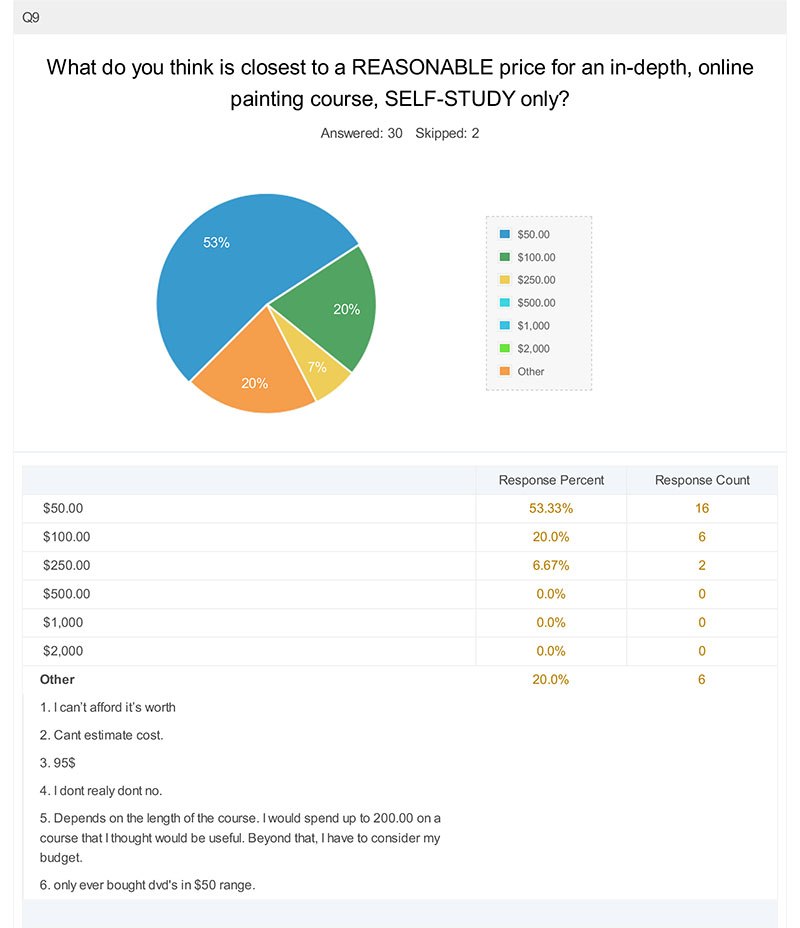
I’m glad that everyone could see the value of a course with critiques included. I love doing critiques and seeing the results my students get with them, but they take time, and so I need to charge a little more for that. And of course, less for a course without critiques. I think my subscriber’s responses here are intelligent and reasonable.
I should have added the question, “How important is a personal critique in a course? Or, put another way, do you prefer “self-study?”
(You can answer that in the comments below if you’d like 🙂 )
Question #10
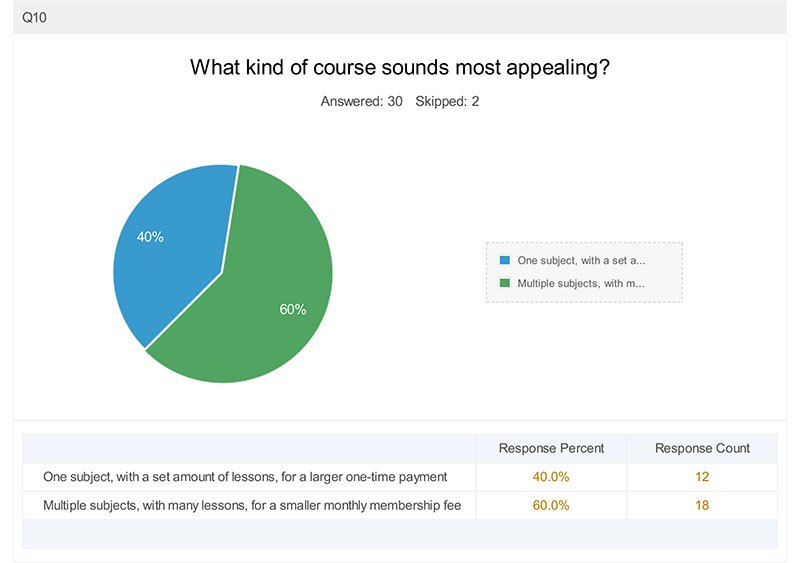
It seems that a majority of my subscribers would like a monthly membership program. I do have one right now: Realistic Acrylic All-Access Membership. With it, you get access to all the courses, plus personal critiques every month.
Question #11
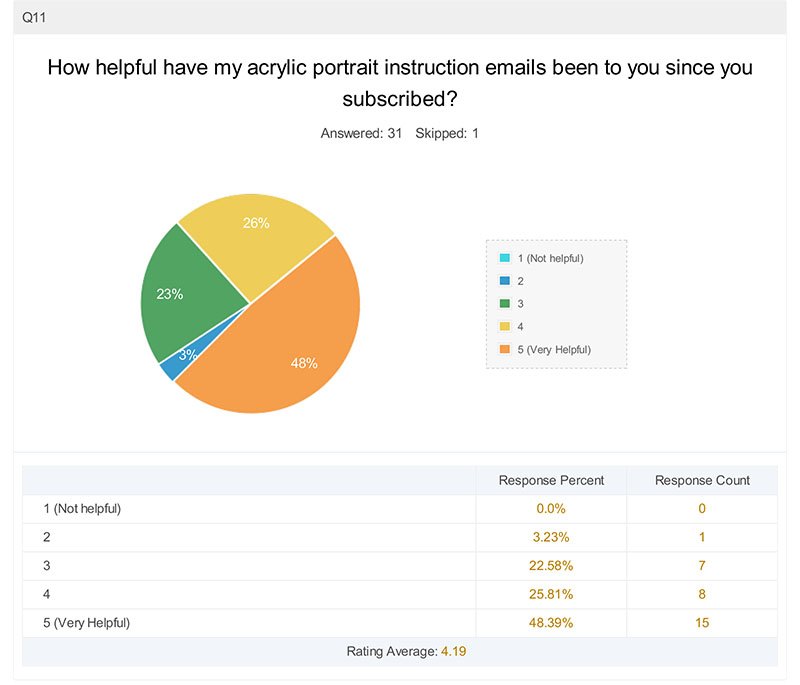
Nearly half have found my emails very helpful, and another quarter have found them pretty helpful. The remainder have found them decent, but not great. I’m glad I’m doing a good job overall, sharing lessons and tips that are useful, but it looks like I can still use some improvement.
I should have done a follow-up question or two: What can I improve on? What would you like to see more of?
Well, I’m asking you right now. 🙂 Let me know!
Question #12
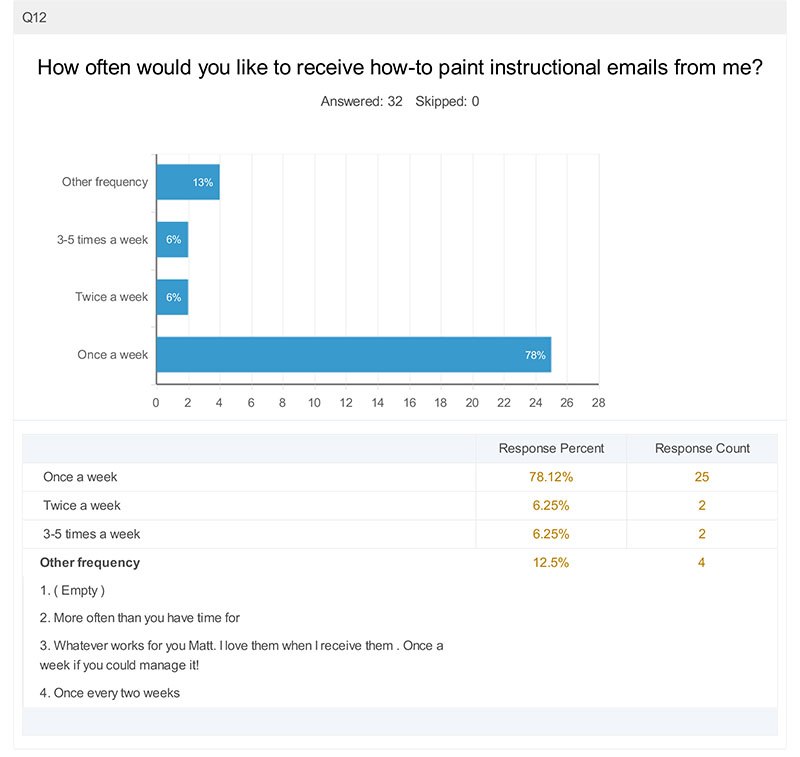
This wasn’t surprising. After all, I normally send an email about once a week, so that is what my subscribers are used to. I recently opted in on an email list for marketing tips, and at a certain point, they sent me 2-3 emails a day!
My inbox could only take so much. Unsubscribed.
Occasionally, I send out an email twice a week, when I have an announcement on a new course or something that’s time sensitive, but I promise my subscribers to never inundate their inboxes!
Additional Comments
Finally, this last question was a freebie. It was wonderful to hear so many honest comments. Since the survey was anonymous, I was unable to respond back personally via email to the people who left the comments, but I will take the opportunity to do that now…
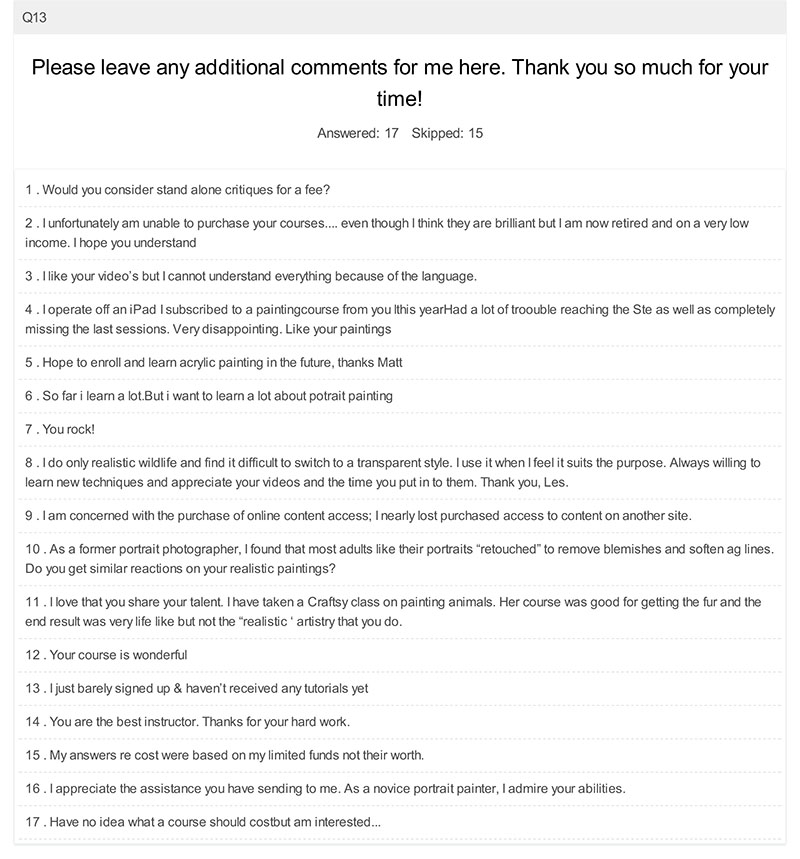
Here are my answers…
1. Would you consider stand alone critiques for a fee?
I would do standalone critiques for a fee, if that works best for you. Although I include a month worth of free critiques within my painting course, I would offer standalone critiques for $15 each.
These are personalized video critiques, like this one here, (approximately 15 minutes long) where I compare your painting next to the original image, discuss what’s working well, and show you exactly how to correct what may be off.
So, if you’re interested, just email me and let me know. I’ll set it up with you.
2 . I unfortunately am unable to purchase your courses…. even though I think they are brilliant but I am now retired and on a very low
income. I hope you understand
Of course I understand. I am still very glad that you’re a subscriber and you can still benefit from my free lessons and videos.
3 . I like your video’s but I cannot understand everything because of the language.
I am sorry about the language issue. Not sure if I can correct that, since I only speak English! Maybe there’s translation services out there for videos?
4 . I operate off an iPad. I subscribed to a painting course from you this year. Had a lot of trouble reaching the site as well as completely
missing the last sessions. Very disappointing. Like your paintings.
Thanks for the compliments on my paintings. I’m sorry if you were disappointed in not being able to access the later videos in the course. Email me. I think I can upload them to a private YouTube channel so you can see them.
5 . Hope to enroll and learn acrylic painting in the future, thanks Matt.
Ok, great, I look forward to teaching you. Maybe you already enrolled! 🙂
6 . So far I learn a lot. But I want to learn a lot about portrait painting.
Good. That’s what I’m here for!
7 . You rock!
Hey, thanks. God has been good to me…just want to pass the blessings along!
8 . I do only realistic wildlife and find it difficult to switch to a transparent style. I use it when I feel it suits the purpose. Always willing to
learn new techniques and appreciate your videos and the time you put in to them. Thank you, Les.
Hi Les, and glad you like the videos and appreciate the time I put into them. I plan on doing a lot more this year!
9 . I am concerned with the purchase of online content access; I nearly lost purchased access to content on another site.
Yikes! That would make me upset too. My courses are hosted by Teachable, and although they are not perfect, they are one of the most dependable learning management systems out there. Most of my students have had a great experience there. However, my course is satisfaction guaranteed, and you can always reach me by email or phone if you’re having problems with anything.
10 . As a former portrait photographer, I found that most adults like their portraits “retouched” to remove blemishes and soften ag lines. Do you get similar reactions on your realistic paintings?
Yes. One client said, “You can take my wrinkles out,” but to leave them on her husband. 🙂
11 . I love that you share your talent. I have taken a Craftsy class on painting animals. Her course was good for getting the fur and the
end result was very life like but not the “realistic ‘ artistry that you do.
Thank you. I am looking to fill a void here on the internet. There’s many teachers, but I haven’t found any that specialize in teaching realistic acrylic portrait painting. So, voila!
12 . Your course is wonderful.
Thank you so much!
13 . I just barely signed up & haven’t received any tutorials yet.
I’m sorry you didn’t get any tutorials yet. It might have been a glitch in my email service provider. Email me if you can and let me know if you still haven’t gotten anything yet!
14 . You are the best instructor. Thanks for your hard work.
Wow, thank you for the kind words!
15 . My answers re: cost were based on my limited funds, not their worth.
Sure, that helps to know that. Thanks!
16 . I appreciate the assistance you have sending to me. As a novice portrait painter, I admire your abilities.
My pleasure. Be blessed in your painting and may God take the skills He’s blessed you with and multiply them ten-fold this year!
17 . Have no idea what a course should cost but am interested…
My main online course, “Paint Your First Amazing Acrylic Portrait” is $97, one time fee. You can find out more or enroll right here.
That wraps it up for my first survey results. Did it surprise you? Does it make you think of anything you’d like to ask me?
Or maybe you’d like to leave a comment on what you’d like me to teach on. How have I been doing and how can I improve? I’d love to hear your thoughts.
Have a blessed day,

